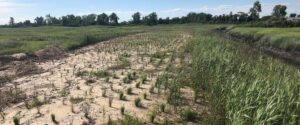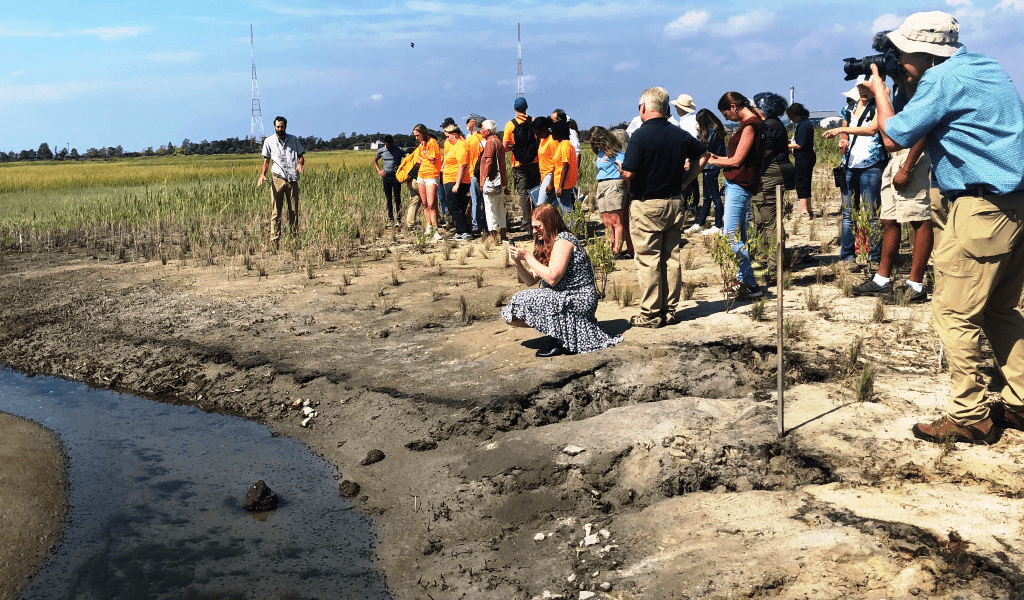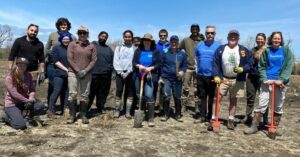On August 30, 2022 a ribbon-cutting ceremony was held in Stratford, Connecticut to celebrate the completion of the ecological restoration of 34 acres of key salt marsh habitat.
As a result of this regenerative work, Connecticut’s coastline has received an exciting, resilient refresh. After years of planning and fundraising, 34 acres of salt marsh and other important coastal habitat has been restored at Great Meadows Marsh, a Globally Important Bird Area, and part of the Stewart B. McKinney National Wildlife Refuge.
The public is now welcome to visit the marsh’s old – and new – trails, and to take in the sights of fall migration via two viewing platforms.
Since construction began in October 2021, Great Meadows Marsh has transformed into a haven for threatened plants and animals, and community access has been greatly improved.
“It was an honor meeting and working with the Stratford high school stewards to help restore the native plant species. You can see new growth already. Many thanks to all who saw this project through many years. The Stewart B. McKinney National Wildlife Refuge and Great Meadows Marsh protect our coast from the effects of climate change, while hopefully fostering continued thoughts of environmental conservation for all of Connecticut,” said Joe Gresko, House Chair of the Environment Committee and State Representative from Stratford.
Over 155,000 native coastal plants and shrubs were added to the site by 12 paid, seasonal “Salt Marsh Stewards” from Stratford and Bunnell high schools – with the help of three crew leaders and over 150 volunteers; a new creek restored the natural flow of salt water in and out with the tides; grassy mounds were created to provide an elevated home for nesting Saltmarsh Sparrows; and two viewing platforms were built (soon to become ADA-accessible).
“This is an incredible accomplishment resulting from the work of so many to restore and revitalize the marsh, protect wildlife, rebuild ecosystems, and combat the effects of climate change. To see this project completed with the restoration of 34 acres of salt marsh is wonderful and transformative. This could not have been done without the 12 students from Stratford and Bunnell high schools who worked as Salt Marsh Stewards, as well as their crew leaders and over 150 volunteers who gave their time. Our entire community shares our deepest gratitude with all who invested in this project to improve CT’s coastline and give our beautiful native plants and wildlife the ability to thrive. I look forward to visiting with my kids and grandkids, and seeing future generations learn about the importance of protecting and preserving our coastline and salt marsh,” said Connecticut Senate Republican Leader Kevin Kelly.
While there is much to celebrate, project partners Audubon Connecticut, the National Oceanic and Atmospheric Administration, U.S. Fish and Wildlife Service, and Connecticut Department of Energy and Environmental Protection will dedicate three additional years to monitoring project outcomes and improving upon their successes. Invasive species will continue to be managed, and additional native plants and shrubs will be put in the ground.
The salt marsh at Great Meadows was once more than 1,400 acres, but largely due to development, it had been reduced to less than 700 acres. As well, because of dredged soils brought in as fill, colonization by non-native plants, and sea-level rise, portions of it no longer functioned properly. The degraded marsh produced abundant mosquitoes that plagued locals and visitors for years.
Now, the restored marsh and its creeks provide healthy habitat for Horseshoe crabs and Blue crabs, the beautiful and endangered Marsh Pink flower, Saltmarsh Sparrow and other migratory birds, and fish like Atlantic Silverside and Menhaden.
“The Salt Marsh Stewards played a vital role in this restoration project, helping to restore 8 acres and create 12 additional acres of high marsh habitat for Saltmarsh Sparrow. Tirelessly and without complaint, the Stewards planted thousands of Spartina patens plugs which have already doubled if not tripled in size. Saltmarsh Sparrow use the thatch from the previous year’s growth to construct their nests. Our hope is that next spring, Saltmarsh Sparrows will find plenty of thatch and decide to try out this new nesting habitat,” said Corrie Folsom-O’Keefe, Bird Conservation Director for Audubon Connecticut.
Since the project was announced in 2019, it grew to represent a $4.65 million investment in Connecticut’s coastline. $3.65 million in support was raised thanks to the U.S. Fish and Wildlife Service, the U.S. Environmental Protection Agency, The Nature Conservancy, the Army Corp of Engineers In Lieu of Fee Program, the Robert F. Schumann Foundation, and the Jeniam Foundation.
“The restoration of the Great Meadows Marsh has been years in the making, and today’s ribbon-cutting is a testament to the strong partnerships between (sic) local, state, and federal agencies and the local volunteers who helped get this project across the finish line. Thanks to their hard work, the marsh has been transformed back into a haven for wildlife and a place for visitors to enjoy the outdoors,” said U.S. Senator Chris Murphy.
Additional project successes include:
- Habitat restored and/or improved for fish and other aquatic wildlife. Over 2,000 linear feet of tidal channels have been created on site. The removal of berms improves access to nesting areas for diamond-backed terrapin turtles.
- Mosquito populations reduced and human health concerns addressed. A more natural flow of salt water in and out of the marsh with the tides – rather than pools of sitting water – has reduced breeding grounds for mosquitoes.
- New strategy tested to create habitat for declining Saltmarsh Sparrow. Within the marsh, scientists built “hummocks” – mounds of dirt that act like elevated islands. On those mounds, they planted grasses that thrive in the high marsh, like saltmeadow cordgrass (Spartina patens) and saltgrass (Distichlis spicata). The elevated hummocks allow Saltmarsh Sparrows to nest higher up in the marsh to avoid fatal flooding. The birds will be monitored next spring and beyond, and if effective, the strategy could be expanded coast-wide.
Funding of nearly $1 million came from three natural resource damage case settlements related to contaminated sites close to the area: Raymark Industries, Lordship Point Gun Club, and Housatonic River/General Electric. These case settlements supported planning and engineering, and leveraged funds for the project construction and future monitoring.
Many local and national leaders praised the project:
 “This is a banner day for Great Meadows Marsh. Less than a year ago, we stood here to announce that this important coastal habitat would be restored and today we celebrate the completion of that worthy and necessary project. This restoration of 34 acres of salt marsh has not only created a healthy habitat for birds, fish, native plants and all kinds of animals, but also a recreation opportunity for people to fish, bird walk and talk a peaceful walk,” said U.S. Senator Richard Blumenthal.
“This is a banner day for Great Meadows Marsh. Less than a year ago, we stood here to announce that this important coastal habitat would be restored and today we celebrate the completion of that worthy and necessary project. This restoration of 34 acres of salt marsh has not only created a healthy habitat for birds, fish, native plants and all kinds of animals, but also a recreation opportunity for people to fish, bird walk and talk a peaceful walk,” said U.S. Senator Richard Blumenthal.
“Working with federal, state, and nonprofit partners on a project with such high return-on-investment for people and wildlife is tremendously gratifying. A healthy Great Meadows Marsh protects nearby communities by absorbing tidal surge during storms that have become more severe due to climate change. It also benefits species like the saltmarsh sparrow—a bird that, without our help, could face extinction due to rising seas. In addition, visitors to Stewart B. McKinney National Wildlife Refuge can enjoy enhanced outdoor recreation,” Kyla Hastie, acting Northeast Regional Director for the U.S. Fish and Wildlife Service.
“NOAA is excited to be part of this unique partnership and restoration effort that is rehabilitating vital saltmarsh—improving habitat for fish and other organisms living in these coastal waters and benefitting the Long Island Sound ecosystem. Healthier marsh habitat in the refuge will also help increase its resilience to climate change. This is a win-win for the environment and local communities impacted by pollution in the area,” said Carrie Selberg Robinson, Director of NOAA’s Office of Habitat Conservation.
“The restoration of Stratford Great Meadows Marsh provides benefits locally, regionally, and globally. It enhances important habitat for many species highlighted in Connecticut’s Wildlife Action Plan such as the state endangered marsh pink, Northern Harriers, and diamondback terrapins. It aligns with efforts of the Atlantic Coast Joint Venture to protect and restore coastal saltmarsh habitat, provides opportunities for diverse communities to enjoy and benefit from our natural world, and helps us address climate change by enhancing the resilience of our coastal marshes—an important source of blue carbon and critical to helping lessen the impacts of severe weather events on our coastal communities,” said Katie Dykes, DEEP Commissioner.
“EPA is proud to be part of this very successful public-private partnership that has restored critical salt marsh and fisheries habitat in Long Island Sound, while also increasing public access to this outstanding resource, especially so close to communities that have been overburdened and underserved. The EPA Long Island Sound Office, which is jointly administered by EPA Regions 1 and 2, will continue to play a key role in leading and coordinating efforts to restore habitat and water quality in this “estuary of national significance,” as it has since it was established 32 years ago,” said David W. Cash, EPA Region 1 Regional Administrator.
“Restoring the Great Meadows Marsh is an important example of using nature-based solutions to help strengthen our coastal environment and combat climate change. Congratulations to everyone who helped bring this project to fruition. We are hopeful that similar projects can be implemented in other coastal areas,” said CT Green Bank President Bryan Garcia.
All photos courtesy of Audubon Connecticut. Featured photo shows lawmakers, volunteers, partners, and Salt Marsh Stewards looking down at a newly-restored creek full of forage fish and fiddler crabs.


